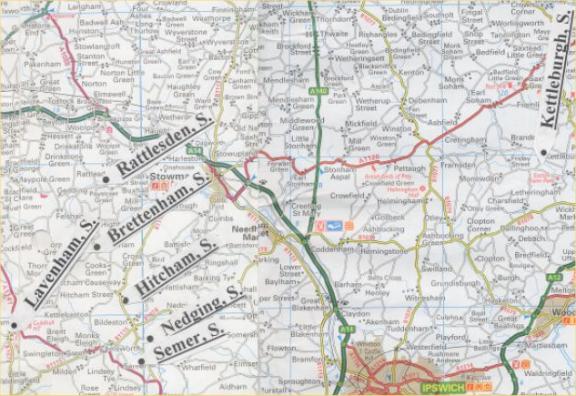The Robinson Ancestral Locations are shown on the following map. Click on a village to go to a description of it.
Henry Kemball (11th-great-grandfather, 1565) was born here about 1565. His mother was Margaret Munning.
Brettenham is a small village at the head of the little river Breton. The village church is called St. Mary the Virgin. There are some old tudor buildings in the village.
Six generations of Kembolds lived here starting with Thomas Kembold (17th-great-grandfather, 1370) who was born here about 1370 and ending with Henry (12th-great-grandfather, 1539) who was born here about 1539. Henry�s grandson, John Kimball (9th-great-grandfather, 1631), was also born here in 1631 and probably emigrated to America.
Hitcham is a village with the 14th-century All Saints Church with a hammer-beam roof in the nave.
Long after our ancestors left in 1837, John Stevens Henslow became the Rector at the Church for twenty years. He was also Professor of Botany at Cambridge University. He brought enlightenment as well as fame to this farming community. He was a mentor of Darwin and was responsible for Charles Darwin going as naturalist on the Beagle (Jobson 145).
Elizabeth Charles (17th-great-grandmother, 1412) lived here. She was probably born here.
Alice Pye (15th-great-grandmother, 1460) was born here about 1460.
Lavenham has been a market town since 1257. It is well known in Suffolk County. It flourished during the Middle Ages because of the wool industry. Residents of the village made immense fortunes from the wool trade. The large village Church of St. Peter and St. Paul is called a wool church. Most of the building dates from 1486 to 1525. The chancel is from the 14th century.
The Guildhall was finished in 1529. It was not a trade but a religious association. The guild was dissolved in 1555, during the Reformation. It has been used as a prison, store, workhouse, Town Hall, and for various other purposes since that time.
There are many beautifully restored Tudor buildings in the town. Most of these buildings were built between 1400 and 1500. There are at least two Hall houses in Lavenham, The Priory and Little Hall. Until the middle of the 16th century, most houses were a single open living area. These were called �hall houses.� There was an open fire in the center. There was a small hole in the roof to let out smoke. The windows were completely open because glass was rare and expensive. In cold weather, the windows were covered with rags or wood. The Priory on Water Street was built about 1300. Little Hall was built in 1390s as a family house and workplace. It provided homes for six familes for about 200 years ( A History of Suffolk, Page 20 and Lavenham. England�s Finest Mediaeval Town).
Humphrey Munning (13th-great-grandfather, 1517), his father, Thomas (1488), and grandfather, Henry (1456), were all born here.
Nedging, is a quiet village with a Church dating back to Norman times. It has a 14th century Dawe bell. The church has an old font in which Norman children were baptized. The north doorway has an 18th century door (Jobson 146).
Ursula Scott (10th-great-grandmother, 1597) was christened here. Her parents, Henry Scott (1571) and Martha Whatlock, (1575) were probably born here too. Richard Kemball (10th-great-grandfather, 1595), the husband of Ursula, was born here too.
Richard Kemball is the 6th-great-grandfather of President Spencer W. Kimball(7th-cousin four-times removed), the twelfth president of the Church of Jesus Christ of Latter-day Saints, or Mormons (see familysearch.org).
Rattlesden is a village off the main road with the St. Nicholas Church. The village is large and open with several greens or commons and picturesque houses. The village stands as one of the unique sources of the River Gipping and once received barges that had sailed all the way from Ipswitch. It is just a ditch today. Stone was sent by barge to build the Church (Olorenshaw).
Ellen Ungle (13th-great-grandmother, 1521) lived here.
Semer is a small rural village with the All Saints Church. It has a three-arched bridge over the Brett River. It once had a workhouse, famed far and wide where the inmates were treated as slaves (Jobson 145).

Brettenham. Map
 St. Mary the Virgin Church in Brettenham.
St. Mary the Virgin Church in Brettenham.
 Font in St. Mary the Virgin Church.
Font in St. Mary the Virgin Church.
Hitcham. Map
 All Saints Church was built in 14th century.
All Saints Church was built in 14th century.
 Interior of All Saints Church.
Interior of All Saints Church.
Kettleburgh. Map
Lavenham. Map
 Church of St. Peter and St. Paul (dates from 14th century).
Church of St. Peter and St. Paul (dates from 14th century).
 Weaver's Cottages built circa 1340.
Weaver's Cottages built circa 1340.
 Little Hall was built in 1390s.
Little Hall was built in 1390s.
 Houses in Lavenham.
Houses in Lavenham.
Nedging. Map
Rattlesden. Map
 Relief in St. Nicholas Church.
Relief in St. Nicholas Church.
Semer. Map

 House in Brettenham.
House in Brettenham.
 Font in All Saints Church.
Font in All Saints Church.
 Guildhall was built in 1529.
Guildhall was built in 1529.
 Houses in Lavenham.
Houses in Lavenham.
 House built about 1480.
House built about 1480.
 Houses in Lavenham.
Houses in Lavenham.
 Norman church in Nedging.
Norman church in Nedging.
 Norman church in Nedging.
Norman church in Nedging.
 St. Nicholas Church.
St. Nicholas Church.
 Font in St. Nicholas Church.
Font in St. Nicholas Church.
 House in Rattlesden.
House in Rattlesden.
 All Saints Church.
All Saints Church.